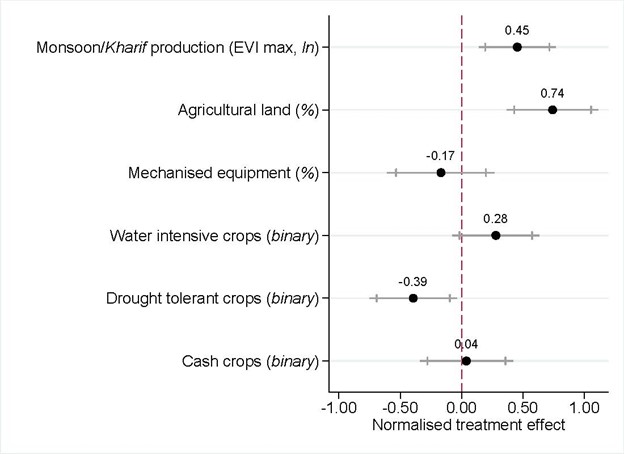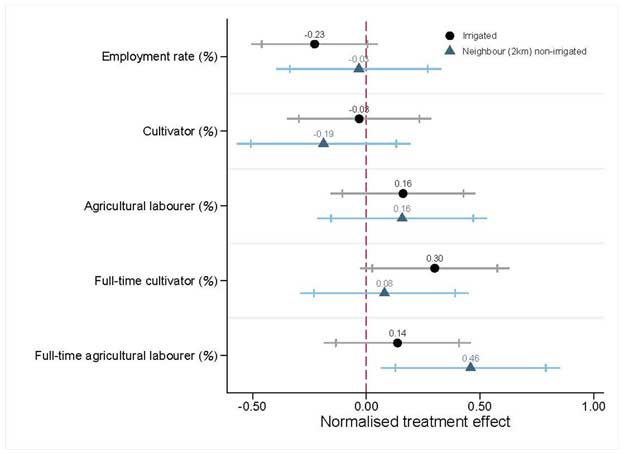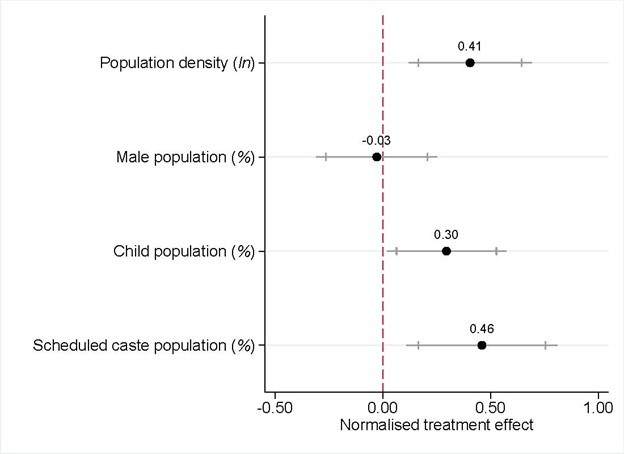Over time, technological advancements accompanied with government energy subsidies have made groundwater the single largest source of irrigation in India. This study evaluates the impact of access to groundwater irrigation on the spatial and sectoral distribution of rural economic activity. It finds a significant improvement in agricultural production accompanied with modest consumption gains, as well as a substantial increase in population density. Access to groundwater also appears to provide additional employment opportunities for agricultural wage labour from surrounding non-irrigated villages.
How agricultural productivity affects the process of economic growth and development is a long-standing question. First discussed with reference to the Industrial Revolution in England during the 18th century, scholars argued that it was a thriving agricultural sector which enabled subsequent industrialisation (Robinson 1954). Ever since, governments around the world have adopted policies to boost agricultural productivity as a means of instigating economic growth.
Irrigation is one of the most conspicuous technologies for stimulating agricultural output. Advancements in the pumping equipment used to extract groundwater revolutionised access to irrigation in India during the 1970s. Generous electricity subsidies to operate these pumps further promoted their adoption. By 2013, groundwater accounted for over 70% of the country’s irrigated land – making it the single largest source of irrigation (Jain et al. 2019).
Our study
In a new working paper (Boudot-Reddy and Butler 2023), we study the impact of access to groundwater irrigation on the spatial and sectoral distribution of rural economic activity in India.
Centrifugal pumps – the most widely adopted irrigation pump – face a physical operational constraint which limits the depth from which they can extract water to approximately 10 meters (depending on altitude).1 Consequently, villages with groundwater depths that can be accessed using a centrifugal pump are much more likely to benefit from groundwater irrigation. Apart from their access to groundwater, villages with groundwater depths just within the operational capacity of a centrifugal pump are likely to be very similar to villages just outside their functional scope. We exploit this natural experiment in a fuzzy Regression Kink (RK) design.2
We match geospatial data on groundwater depth from observational wells to a wide range of administrative and satellite data at the village level. We limit our sample to villages which had built tube wells by 2013 and had groundwater depth within an optimal bandwidth of the kink point, covering over 3,000 villages from across 423 districts in 19 states of India. Our outcome variables are recorded between 2011 and 2013, by which time half of the villages in our sample had access to irrigation for at least 14 years, hence capturing the long- to medium-run effect of the technology.
Key findings
Our results indicate that irrigation significantly improves agricultural production (Figure 1). Additionally, we see that farmers appear to re-optimise their production choices by (i) increasing the share of land cultivated, (ii) moving away from drought tolerant crops, and (iii) growing more water intensive crops. These gains in agricultural productivity translate to modest improvements in consumption. Specifically, we find an increase in the ownership of household assets, especially solid housing. However, there is no effect on predicted consumption per capita or the poverty rate.
Figure 1. Impact of irrigation on agriculture

Notes: i) This figure presents coefficient plots (estimate along with confidence interval) for standardised fuzzy regression kink estimates of the effect of irrigation on agricultural output and production choices. ii) Production is proxied using maximum enhanced vegetation index (EVI) (log transformed), an index of vegetation cover from satellite imagery. iii) Agricultural land is measured as the percentage share of village area used for agricultural purposes. iv) Mechanisation is the percentage share of households who own mechanised farm equipment. v) We capture three binary measures (taking on a value of 1 or 0) of crop choice: does a village grow water intensive crops (sugarcane, cotton, and rice), drought tolerant crops (millet, sorghum, maize, pigeon pea, and groundnut) and cash crops (sugarcane, oilseed, cotton, and tobacco).
An increase in agricultural production with improved irrigation may simultaneously increase demand for labour in this sector. This effect, however, may be small or even reversed if farmers switch to less labour-intensive crops or adopt labour saving technologies such as transplanters and harvesters. Furthermore, labour supply to agriculture is likely to be influenced by market opportunities in other sectors. On-farm growth may increase demand for non-agricultural goods leading to a reallocation of labour to other industries. Characterised by these complex interactions, the overall effect of irrigation on the sectoral allocation of labour is ambiguous.
We find that access to irrigation has no effect on the employment rate or labour re-allocation between sectors of the local village economy. Interestingly however, when we consider the employment status of residents in the nearest neighbouring village from our sample that had no tube wells in 2013, we find a substantial movement of labour from non-irrigated villages to irrigated villages (Figure 2). Specifically, there is a significant increase in the share of full-time agricultural labourers in neighbouring villages that have not adopted groundwater irrigation. This evidence suggests that tube wells provide villages with a comparative advantage in farming, pooling-in labour from less agriculturally productive neighbouring villages.
Figure 2. Impact of irrigation on labour distribution

Notes: i) This figure presents coefficient plots (estimate along with confidence interval) for standardised fuzzy regression kink estimates on the effect of irrigation on aggregate and agricultural sector employment. ii) Employment rate refers to the percentage share of the working age population in employment. iii) Agricultural sector employment is captured as the percentage share of the workforce engaged as cultivators or agricultural labourers. Full-time employment is the percentage share of the those labourers engaged as full-time workers.
Finally, we consider the effect of access to irrigation on village demographics. We observe a large shift in population density (Figure 3). This is likely due to two main pathways: (i) a more productive agricultural sector may spur in-migration, and (ii) it may increase consumption in a way that sustains higher fertility and/or reduced mortality. In an attempt to identify the migration pathway, we consider the population share of men as well as Scheduled Castes, two groups known to migrate for work. While we find no significant shifts in the share of the male population, Scheduled Castes are over-represented in villages with better access to irrigation. Secondly, to address the fertility and/or mortality pathway we consider changes in the share of village population by age group. Our findings indicate a significant increase in the share of children (0 to 6 years) in the population of villages with better access to irrigation.
Figure 3. Impact of irrigation on village demographics

Notes: i) This figure presents coefficient plots (estimate along with confidence interval) for standardised fuzzy regression kink estimates on the effect of irrigation on village demographics. ii) Population density is the ratio of population to village area. Male, child and scheduled caste population is measured as the percentage share of that group to the total population.
Conclusion
Our research provides evidence that while the recent revolution in groundwater irrigation boosted agricultural productivity, it did not bring manufacturing firms and employment opportunities in services to rural communities. It did, however, change local agricultural sector employment opportunities by pooling-in labour from less productive neighbouring areas. Furthermore, irrigation also led to a substantial demographic shift across the country – increasing fertility rates and the share of children in the population, as well as attracting members of scheduled castes. This is likely to have a profound longer-term impact on economic growth as the next generation enters the labour market.
Notes:
- Centrifugal pumps operate by generating a pressure differential between the water table and the pumping mechanism installed at ground level. At sea-level and under a perfect vacuum in the pumping mechanism, the maximum depth from which water can be extracted by a centrifugal pump is 10.33 meters. Below this depth, no centrifugal pump will be operational. Extracting water from greater depths requires significantly more expensive, and hence rarely adopted, submersible pumps which are placed at the bottom of a tube well and push water to the surface.
- A regression kink design can be used to identify casual effects in settings where the regressor of interest is a kinked function of an assignment variable. In this study, we propose that centrifugal pumps are drawn from a distribution of efficiencies, leading to a gradual decline in adoption of the technology and culminating in zero take-up at the exogenously derived maximum theoretical depth. This generates a kink in the assignment function that describes the relationship between irrigation and groundwater depth. It follows that if irrigation exerts a causal effect on our outcome variables, we should then expect to also see an induced kink in the relationship between the outcome and groundwater depth. This allows us to estimate the causal impact of irrigation on agricultural production and the distribution of economic activity.
Further Reading
- Boudot-Reddy, C and A Butler (2023), ‘Watering the Seeds of the Rural Economy: Evidence from Groundwater Irrigation in India’, Working Paper. Available at SSRN.
- Jain, Rajni, Prabhat Kishore and Dhirendra Kumar Singh (2019), “Irrigation in India: Status, challenges and options”, Journal of Soil and Water Conservation, 18(4): 354-363.
- Robinson, Austin (1954), “The changing structure of the British economy”, The Economic Journal, 64(255): 443-461.




 12 January, 2024
12 January, 2024 





Comments will be held for moderation. Your contact information will not be made public.